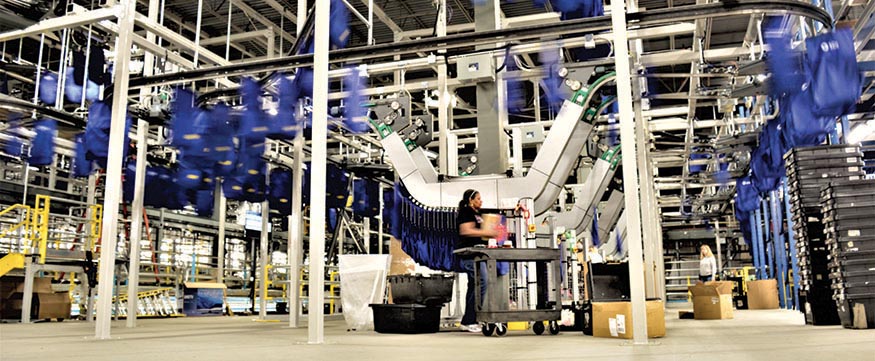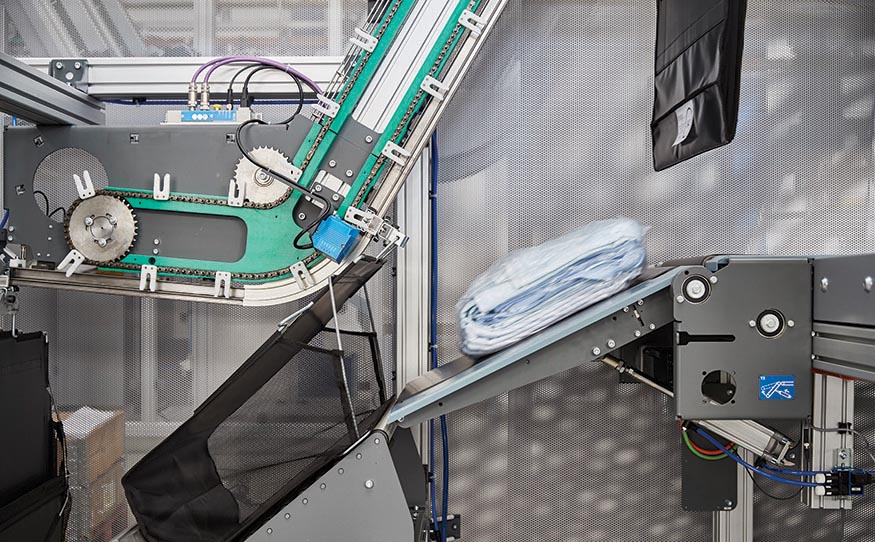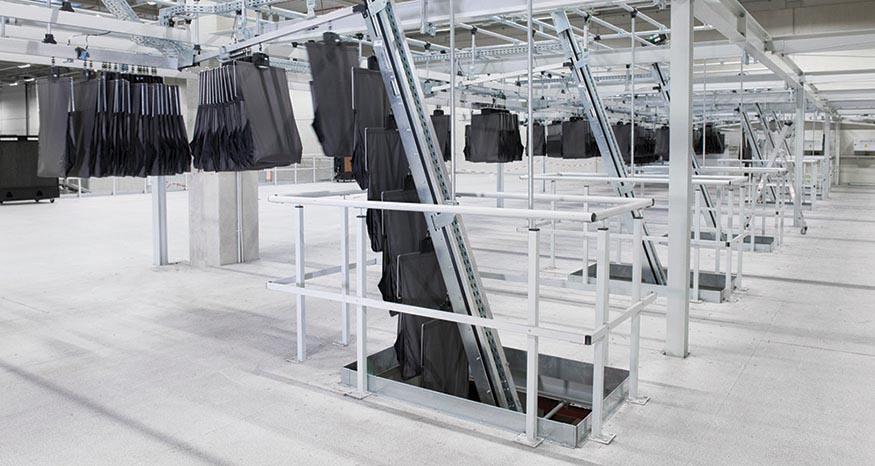Equipment Report: Pouch and pocket sorters shake up e-commerce distribution
With e-fulfillment driving the need for high-rate order consolidation, pouch/pocket sortation systems address a number of top e-commerce challenges.
Distribution technologies that were initially built to support retail brick-and-mortar locations have done an admirable job adapting to the e-commerce revolution. Direct-to-consumer (D2C) fulfillment has pushed technology to the limit as end users work to squeeze every penny, second and square inch from their facilities. It might come as a surprise, then, that a 50-year-old technology designed for a very specific niche could be just what the industry needs.
The volume and complexity of e-commerce order fulfillment has created the need for solutions that streamline piece picking, says Ken Ruehrdanz, manager of the distribution systems market for Dematic. Solutions that store, transport, sort, sequence and consolidate eaches are in demand. “A pouch system can accommodate all of those. The pouch system is now the centerpiece and fulfillment engine for e-commerce distribution centers,” Ruehrdanz says.
If you’ve never heard of pouch or pocket sortation systems, don’t worry. Ross Halket, vice president of intralogistics sales for WRH Global Americas, says there aren’t many pouch systems in North America yet.
“There are fewer than a dozen that I know of, but a lot of customers are at the point now where they were with shuttles a few years ago,” Halket says. “They’re keeping it close to the chest because they don’t want competitors to know.”
Consolidate in advance
Pouch sortation started in the garment industry. The simple rail systems densely stored and singulated premium clothing on hangers, but they also proved effective for sorting items into vehicles in route sequence. The specialized technology lingered quietly for decades, serving primarily the fashion industry. Meanwhile, the retail industry churned ever closer to omni-channel and D2C capabilities by innovating with conventional distribution technologies.

Acting as a dynamic wave buffer, pocket sortation systems allow for massive batches and waves, pre-allocating and efficient order consolidation.
According to Dave Simpson, executive director of ASD sales for SSI Schaefer Systems International, even some of the most advanced warehouse automation has a breaking point. Demand for higher singulation and consolidation has only grown, with warehouses evolving from thousands to hundreds of thousands of SKUs. Items picked throughout the building must come together for an order.
“In retail you have 50 to 100 items coming together, then with direct-to-consumer it’s two or three,” Simpson says. “Regardless of order size, consolidation became harder and harder in our industry. You see many sorting solutions trying to solve for that, like unit sorters, tilt tray, bomb bay and sliding shoe. For all of them, the end goal was to take all inventory picked in the warehouse and consolidate it into a single order or group of orders.”
However, these conventional sortation technologies couldn’t quite do the job by themselves. Users might add induction points to try to increase performance, Simpson says, but there’s still the need to bring items to the induction area. On the back end, limited destinations led to widespread adoption of “after sort” systems like put walls.
“Add 20 locations after sort and you go from 100 destinations to 2,000, but that’s a lot of touching going on,” Simpson says. “A touch to pick, to induct, to post-sort, to pack out, just to get an order consolidated.”
Halket says high-velocity systems typically have four touches before packout, and pouch systems cut that in half. The pouch becomes the put wall right from the pick face, he says, saving at least two touches per unit. As an added bonus, any single-item orders, whether 1% or 15% of orders, can bypass the entire sort process and take a straight rail to packout, Halket says.
Each touch adds an opportunity for error. Carousels and put walls that achieve more than 99.7% accuracy were good enough for retail, says Rudi Lueg, senior vice president of sales for Knapp. One customer with several pouch modules, on the other hand, pushed out 500 million items in a day and tallied three errors. That’s a 0.0000006% error rate.
“For direct-to-consumer, pockets are one of the few technologies that are really suitable,” Lueg says. “If inside the four walls you try to cut costs and throw bodies at problems, forget about it. One of our pouch customers is done on Black Friday at 5 p.m. or 6 p.m., while another facility could be digging out of Black Friday for another week.”
A buffer above
The benefits of pouch and pocket systems center around space, capacity and rate. Ruehrdanz says pouch systems use overhead space effectively, storing and buffering in tight, compact rows. The rail system offers cost-effective accumulation of lots of inventory. Typical systems range from 25,000 to 150,000 pouches, Ruehrdanz says, and typical throughput ranges from 2,500 to 12,000 items per hour.
Pick modules and goods-to-person stations are a good complement to pouch sortation. The operator—or conveyor or cobot—can pick for hundreds of orders at a time. Each pouch only ever holds one item, which won’t be touched again until packout. Simpson says large systems support huge batch picking.
“The problem with batches or waves, generally, is they are limited in size,” Simpson says. “Think about picking for a crossbelt sorter. Wave size can be no larger than the number of open orders, so you have to throttle the size of waves.”
Lueg adds that in a conventional wave of 2,000 items, if you miss five items the whole wave is stuck. “IT guys love waves, operations hates waves,” he says. Pouch sortation works as waveless in a wave environment, so everyone is happy.
However, if a pouch system has a three-hour wave capacity, Halket says, “give it all to me. Don’t parse and analyze, just give it all and within those pouches I now have three hours of work hanging above me.”
Pouches achieve this performance by functioning as a buffer at a scale and efficiency few other sortation systems can match. The physical infrastructure for pouch systems is very accommodating, according to Simpson. He says multiple levels can be routed around nooks and crannies in the warehouse with no physical floor space taken, and because pouches conform to their contents there is virtually zero wasted space. Compare this to the use of a tilt tray carrying a thumb drive.

Pouches become put walls directly from the pick face, which might be staffed by a human, conveyor or cobot.
One big shuttle or other storage engine can support pick stations where a person or cobot loads a pouch, Halket says. Using gravity as much as possible cuts the need for hundreds of drives in the air, he adds. This reduces the already low maintenance pouches require as an easy-to-clean technology with fewer components.
“One client used $600 in parts in two years,” Halket says. “These are very simple systems compared to the servos and switches and elements in traditional sorters and conveyors.”
Dynamic waves
A pouch system’s dynamic wave buffer enables a high degree of efficiency and preparedness. Lueg offers the example of an upcoming sale on red T-shirts. You’re fairly confident you will sell 10,000, but certain you will sell at least 5,000. It’s possible to pre-load the pockets with the 5,000 and if you sell 8,000 when busy you only need to load 3,000 more.
Suppose promotional efforts create 100 high-speed SKUs, Simpson says. You can pick each discrete order as it comes in or do waves in full case increments. Say 20 units are in a case and the wave needs six. Induct all 20, and the six are allocated while 14 go into a holding pattern.
“Use this dynamic wave buffer with a select number of SKUs you’re confident will sell, and as orders come in those units will be immediately allocated,” Simpson says. “This is different from a replenishment model where there are min/max thresholds and you have paid someone to go get a case, open it and make it available for one or two picks.”
Dynamic wave buffers are great not just for residuals and pre-picking, Simpson says, but for returns. Anything designated as return to stock goes into the buffer to fill the next order right away.
Krish Nathan, CEO of SDI Systems, says one pouch customer used 50% of returns within 24 hours. Their system has hundreds of thousands of pouches, with a buffer of between 60,000 to 100,000. A business with 40,000 SKUs and a buffer of that size might pre-load two of each SKU, Nathan says, simply because they know they will need them eventually.

As opposed to a shuttle’s tote- or carton-level storage and retrieval, Nathan says a pouch system’s dynamic buffer is a unit-level storage and retrieval engine.
“Pouches are a super exciting technology that now actively tracks everything at the unit level,” Nathan says. “Because you know where everything is, you know what you don’t have. A challenge in most e-commerce operations is the tail, the things you didn’t pick and any exceptions. This technology gives you loads of flexibility to handle exceptions because you know what they are.”
For example, in a traditional tilt tray and put wall environment, packout finds exceptions. If a picker gets the wrong size shoe, Nathan says, someone now has to put the wrong size away and do a hot pick to get the right one. The result is that 80% of fulfillment time is spent dealing with 20% of the orders.
“99.99% accuracy is a traditional target,” Nathan adds, “but in e-commerce at 20,000 items an hour that’s 20 problems to solve every hour, which takes an inordinate amount of time.”
Similarly, if one customer orders something and then 30 minutes later orders something else, you have two orders. Once the first order is released, it’s too late to modify it. Pouches can hold and combine the two orders before releasing them to the packer.
Nathan says pouches further boost accuracy because their identification, whether RFID or bar code, is in the same place every time. Once product is married to the pouch, scanners and low-price cameras can be distributed through the system.
“You can guarantee 100% accuracy because just before it’s diverted to a pack station it’s scanned one more time,” Lueg says. “If something is wrong, it’s flagged right there. It’s essentially automated quality assurance for every pack station.”
Halket highlights pouches’ promise in the third-party logistics space, where a pouch system lends itself to whatever contracts might come. From cell phones to teddy bears to frying pans, Halket says it can be done with a combination of pouch sorter and shuttle.
“These are no-brainers in my mind,” he says. “People should not only be looking at pouches, but getting in line to purchase them. The big ones who have done their pilots are now greenfielding, and retrofits are easy because they can go above anything. The technology is coming from both angles.”
Traditional brick-and-mortar retail technology in a D2C environment impacts productivity, accuracy and flow, Lueg says. “All those things are beautifully solved with pouches.”
Companies mentioned in this article:

Article Topics
Equipment Report News & Resources
Radial stays ahead of the automation curve Wireless Mobility: Ready for the next leg up AGVs set new standards for inventory transportation Inside North Shore Care Supply: Bringing robots to receiving Bergen Logistics: Putting robots to work in a multi-tenant facility High-tech meets low-tech: Automate storage for pallet loads Tuggers, carts work together to increase productivity and ergonomics More Equipment ReportLatest in Materials Handling
Registration open for Pack Expo International 2024 Walmart chooses Swisslog AS/RS and software for third milk processing facility NetLogistik partners with Vuzix subsidiary Moviynt to offer mobility solutions for warehouses Materials Handling Robotics: The new world of heterogeneous robotic integration BSLBATT is looking for new distributors and resellers worldwide Lucas Watson appointed CSO for Körber’s Parcel Logistics business in North America Hyster recognizes Dealers of Distinction for 2023 More Materials HandlingAbout the Author
Subscribe to Materials Handling Magazine

Find out what the world's most innovative companies are doing to improve productivity in their plants and distribution centers.
Start your FREE subscription today.
April 2024 Modern Materials Handling

Latest Resources












